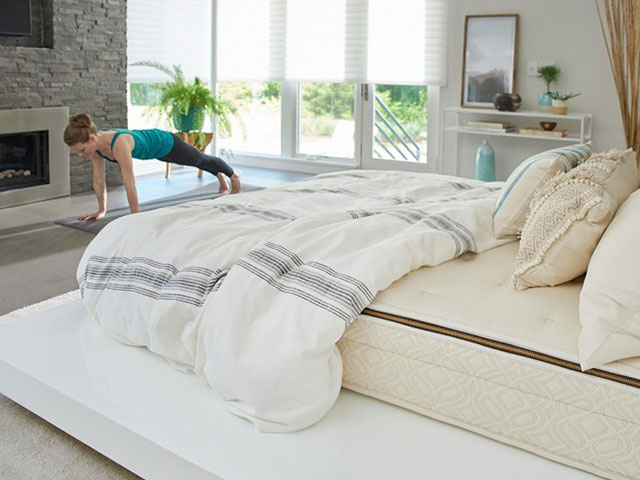Via Naturepedic Blog
Once upon a time, furniture and textiles in homes were made using natural materials. Before furniture factories and mass-produced materials, things like couches, curtains, rugs, and mattresses were made with materials directly found in nature — such as wood and cotton.
Through the years, innovations in technology and manufacturing made it easier, cheaper, and faster to produce these same products. But these innovations came at a cost to our health and wellness, as the materials now being used are often ripe with questionable chemicals.
According to Naturepedic co-founder and environmental engineer Barry Cik, “Companies started adding petroleum to almost everything. Natural fibers aren’t nearly as flammable, but petroleum is much cheaper.”
To see this truth in action, check out this video to witness the difference between a modern home fire with petroleum-based furnishings and a legacy home fire with more natural furnishings.
Because petroleum is so commonly used in everyday furnishings and textiles, America introduced flame retardants and flammability standards in the 1970s to make sure that these products were fire-safe.
What are flame retardants?
Flame retardants are chemicals that are added to building materials, electronics, and furniture with the intention of preventing or slowing fires.
Flame retardants can be found in (but are not limited to):
- Building and construction materials: insulation materials, such as polystyrene and polyurethane insulation foams
- Electronics: computers, laptops, phones, televisions, wires, and cables
- Furnishings: upholstery, mattresses, carpets, and curtains
- Transportation products: vehicle seats, car seats, bumpers, overhead compartments, automobiles, airplanes, and trains
Despite assurance claims made by the chemical industry, many of these flame retardants are unnecessary, harmful to health, and don’t work well.
Some studies link flame retardants to neurological impairments, hormone disruption, decreased fertility, and cancer. Moreover, if humans are exposed to these toxic chemicals over time, they have been shown to bioaccumulate, which could potentially cause certain chronic health problems. Mothers have even been known to pass flame retardant chemicals to their babies through breastfeeding.
This is why the chief cause of death for firefighters isn’t actually fires, but chemical exposure during the line of duty, which often leads to terminal cancer. Clearly, flame retardants present a major issue in our society that has been ignored for way too many years of manufacturing and production
Here’s how you can avoid flame retardants
By now, you’re probably ready to start reducing your exposure to flame-retardant chemicals, and we don’t blame you. Fortunately, the Environmental Working Group has a great resource to help identify common exposures and ways to avoid flame retardants, including:
- Research baby products before you buy them to make sure you select items made without flame retardants
- Choose new furniture made without flame retardants
- Replace your couch’s foam when you have it reupholstered
- Inspect foam-containing furniture for damage and degradation
- Use a vacuum with a HEPA air filter to trap small particles and contaminants
- Use caution when removing old carpeting
- Choose children’s pajamas made from natural fibers with a snug fit
Of course, you should also know what you’re looking at when it comes to reading product labels. With Naturepedic’s products, you can trust that each one meets all federal flammability standards without the need for flame-retardant chemicals or chemical flame barriers of any kind.
Flame retardants in mattresses
The simple truth is that you spend eight or more hours a day in bed, surrounded by whatever materials are in your mattress. Choosing a mattress made without flame retardants helps you avoid exposure to toxic chemicals for at least a third of your day. (Remember, too, that babies spend up to 18 hours a day sleeping, so their crib mattress is a crucial component of a safer sleep environment in your home.)
As you make certain changes in your everyday purchases to avoid products containing flame retardants, your mattress is clearly the best place to start. By making this one simple change and selecting an organic Naturepedic mattress that’s free from flame retardants and other toxins, you’ll already be spending much less of your day surrounded by dangerous chemicals.
Working toward a flame-retardant-free future
Advocating for the disuse of flame retardants is thus extremely important for the sake of our health and wellbeing from the time we’re born. As more people learn about the true dangers of petroleum-based products and flame retardants, it’s inevitable that change will come.
Already, certain states are creating and enforcing legislation that bans classes of flame retardants. In 2016, Washington passed a bill to ban five flame retardants. California is also making changes to previous bills to eliminate the use of specific chemicals.
—
At Naturepedic, we simply don’t include flame retardants because our products are made with materials that are naturally fire resistant. Spreading awareness is the first step towards making changes. For more information about flame retardants, please visit the National Institute of Environmental Health Sciences.


